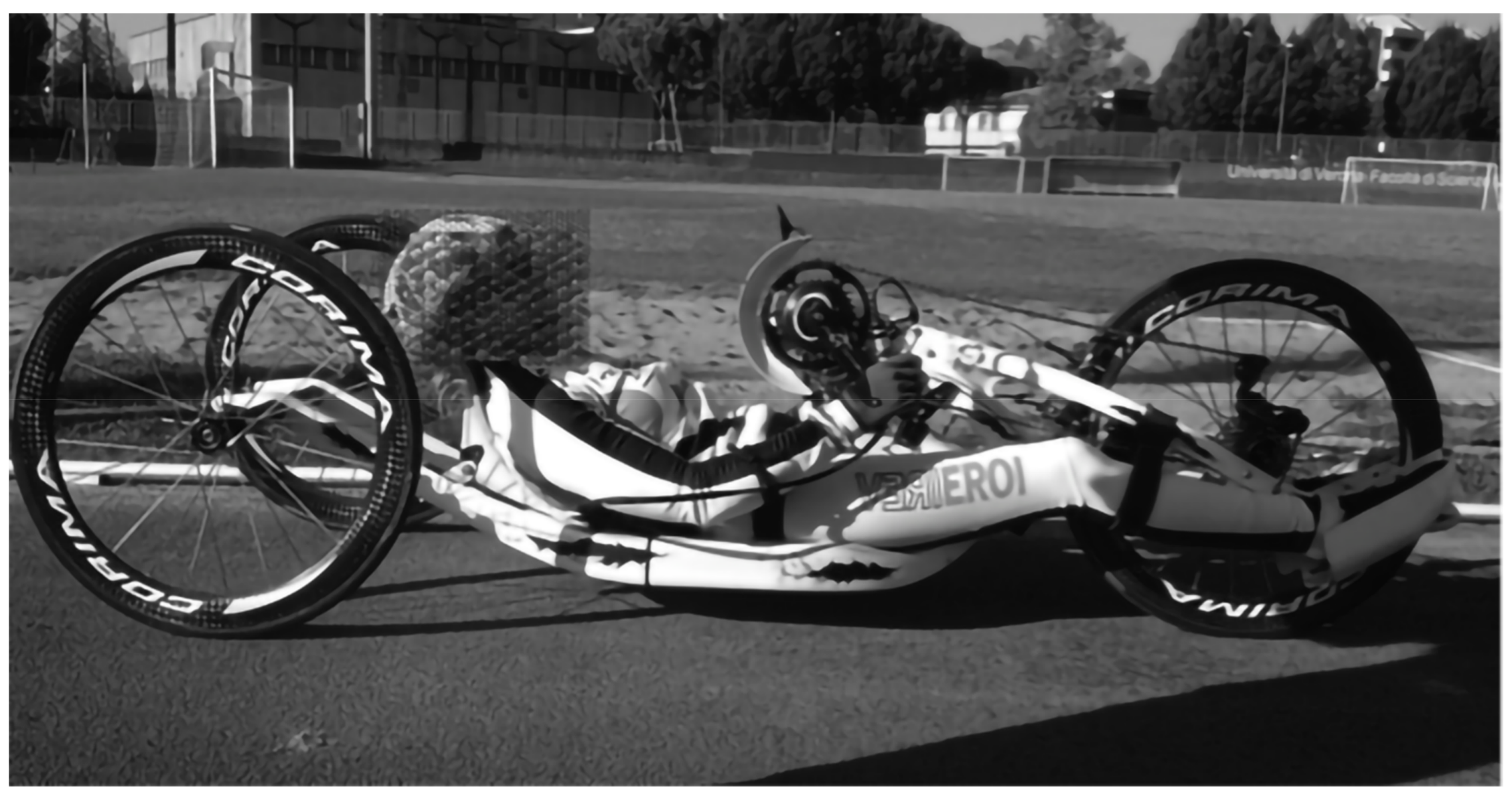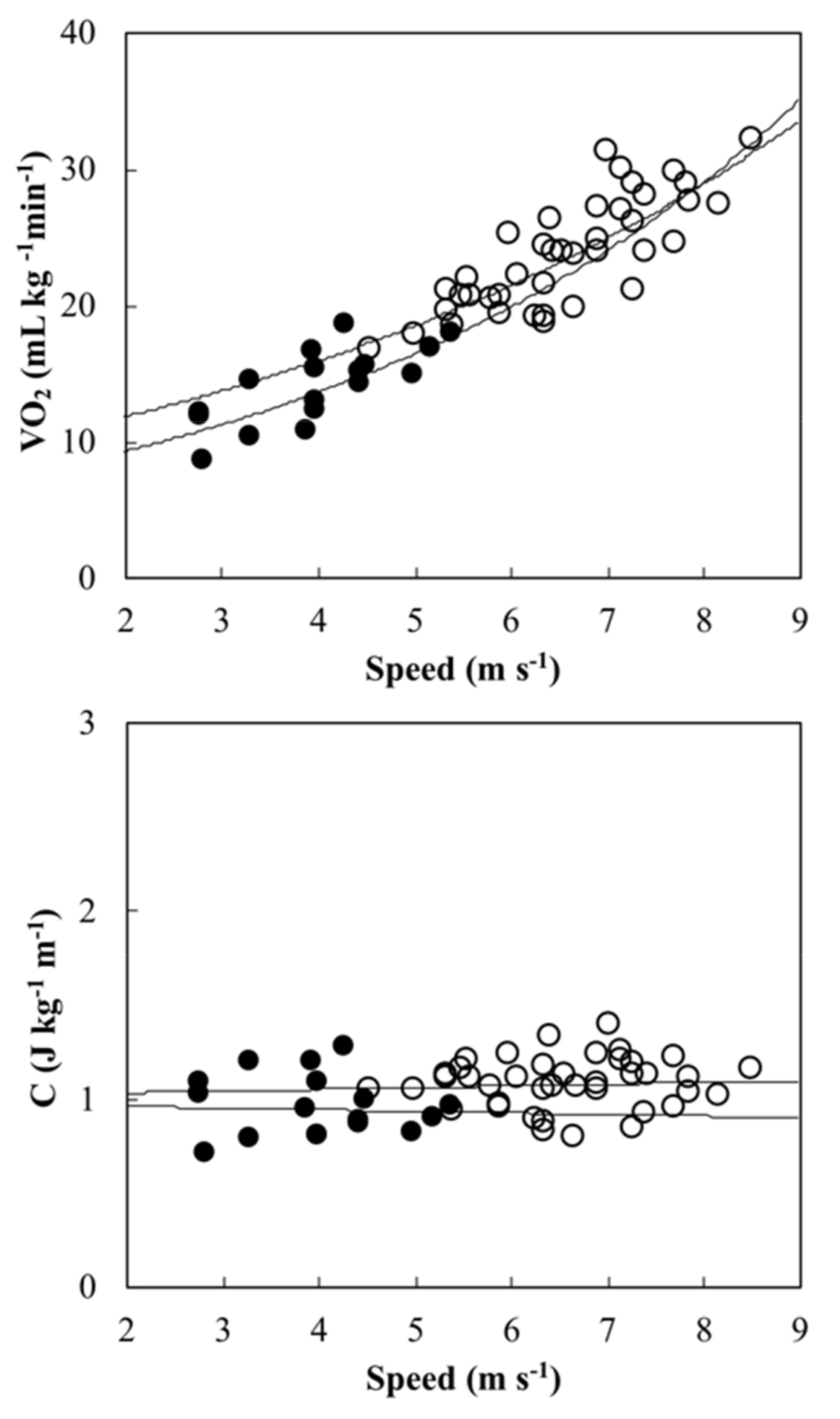Bioenergetics and Biomechanics of Handcycling at Submaximal Speeds in Athletes with a Spinal Cord Injury
Abstract
1. Introduction
2. Materials and Methods
2.1. Participants
2.2. Handbikes
2.3. Procedures
2.4. Mechanical Tests
2.5. Calculations
2.5.1. Bioenergetics Measurements
2.5.2. Biomechanical Measurements
2.6. Statistical Analysis
3. Results
4. Discussion
5. Conclusions
Author Contributions
Funding
Acknowledgments
Conflicts of Interest
References
- Bakkum, A.J.; de Groot, S.; Stolwijk-Swüste, J.M.; ALLRISC; van Kuppevelt, D.J.; van der Woude, L.H.; Janssen, T.W. Effects of hybrid cycling versus handcycling on wheelchair-specific fitness and physical activity in people with long-term spinal cord injury: a 16-week randomized controlled trial. Spinal Cord 2015, 53, 395–401. [Google Scholar] [CrossRef]
- Hettinga, F.J.; Valent, L.; Groen, W.; van Drongelen, S.; de Groot, S.; van der Woude, L.H. Hand-cycling: an active form of wheeled mobility, recreation, and sports. Phys. Med. Rehabil. Clin. N. Am. 2010, 21, 127–140. [Google Scholar] [CrossRef]
- Janssen, T.W.; Dallmeijer, A.J.; van der Woude, L.H. Physical capacity and race performance of handcycle users. J. Rehabil. Res. Dev. 2001, 38, 33–40. [Google Scholar]
- Abel, T.; Burkett, B.; Schneider, S.; Lindschulten, R.; Strüder, H.K. The exercise profile of an ultra-long handcycling race: the Styrkeprøven experience. Spinal Cord 2010, 48, 894–898. [Google Scholar] [CrossRef]
- Fischer, G.; Tarperi, C.; George, K.; Ardigò, L.P. An exploratory study of respiratory muscle endurance training in high lesion level paraplegic handbike athletes. Clin. J. Sport Med. 2014, 24, 69–75. [Google Scholar] [CrossRef] [PubMed]
- Fischer, G.; Figueiredo, P.; Ardigò, L.P. Physiological Performance Determinants of a 22-km Handbiking Time Trial. Int. J. Sport Physiol. Perform 2015, 10, 965–971. [Google Scholar] [CrossRef] [PubMed]
- uci.org. Available online: https://www.uci.org/docs/default-source/rules-and-regulations/part-xvi--para-cycling.pdf?sfvrsn=47af1c56_34 (accessed on 30 July 2019).
- Tweedy, S.M.; Vanlandewijck, Y.C. International Paralympic Committee position stand--background and scientific principles of classification in Paralympic sport. Br. J. Sports Med. 2011, 45, 259–269. [Google Scholar] [CrossRef] [PubMed]
- van der Woude, L.H.; Dallmeijer, A.J.; Janssen, T.W.; Veeger, D. Alternative modes of manual wheelchair ambulation: an overview. Am. J. Phys. Med. Rehabil. 2001, 80, 765–777. [Google Scholar] [CrossRef]
- Bernardi, M.; Janssen, T.W.; Bortolan, L.; Pellegrini, B.; Fischer, G.; Schena, F. Kinematics of cross-country sit skiing during a Paralympic race. J. Electromyogr. Kinesiol. 2013, 23, 94–101. [Google Scholar] [CrossRef]
- Groen, W.G.; van der Woude, L.H.; De Koning, J.J. A power balance model for handcycling. Disabil. Rehabil. 2010, 32, 2165–2171. [Google Scholar] [CrossRef]
- Capelli, C.; Ardigò, L.P.; Schena, F.; Zamparo, P. Energy cost and mechanical efficiency of riding a human- powered recumbent bicycle. Ergonomics 2008, 51, 1565–1575. [Google Scholar] [CrossRef] [PubMed]
- Lovell, D.; Shields, D.; Beck, B.; Cuneo, R.; McLellan, C. The aerobic performance of trained and untrained handcyclists with spinal cord injury. Eur. J. Appl. Physiol. 2012, 112, 3431–3437. [Google Scholar] [CrossRef] [PubMed]
- Ardigò, L.P. Low-cost match analysis of Italian sixth and seventh division soccer refereeing. J. Strength Cond. Res. 2010, 24, 2532–2538. [Google Scholar] [CrossRef] [PubMed]
- di Prampero, P.E. The energy cost of human locomotion on land and in water. Int. J. Sports Med. 1986, 7, 55–72. [Google Scholar] [CrossRef] [PubMed]
- Minetti, A.E.; Pinkerton, J.; Zamparo, P. From bipedalism to bicyclism: evolution in energetics and biomechanics of historic bicycles. Proc. Biol. Sci. 2001, 268, 1351–1360. [Google Scholar] [CrossRef]
- Debraux, P.; Grappe, F.; Manolova, A.V.; Bertucci, W. Aerodynamic drag in cycling: methods of assessment. Sports Biomech. 2011, 10, 197–218. [Google Scholar] [CrossRef]
- Figoni, S.F. Spinal Cord Disabilities: Paraplegia and Tetraplegia. In ACSM’s Exercise Management for Persons with Chronic Diseases and Disabilities, 2nd ed.; Durstine, J., Moore, G., Eds.; Human Kinetics: Champaign, IL, USA, 2003; pp. 247–253. [Google Scholar]
- Mills, P.B.; Krassioukov, A.V. Autonomic function as a missing piece of the classification of paralympic athletes with spinal cord injury. Spinal Cord 2011, 49, 768–776. [Google Scholar] [CrossRef]
- Theisen, D. Cardiovascular determinants of exercise capacity in the Paralympic athlete with spinal cord injury. Exp. Physiol. 2012, 97, 319–324. [Google Scholar] [CrossRef]
- West, C.R.; Mills, P.; Krassioukov, A.V. Influence of the neurological level of spinal cord injury on cardiovascular outcomes in humans: a meta-analysis. Spinal Cord 2012, 50, 484–492. [Google Scholar] [CrossRef]
- Ardigò, L.P.; Saibene, F.; Minetti, A.E. The optimal locomotion on gradients: walking, running or cycling? Eur. J. Appl. Physiol. 2003, 90, 365–371. [Google Scholar] [CrossRef]
- Bafghi, H.A.; de Haan, A.; Horstman, A.; van der Woude, L.H. Biophysical aspects of submaximal hand cycling. Int. J. Sports Med. 2008, 29, 630–638. [Google Scholar] [CrossRef] [PubMed]
- Dallmeijer, A.J.; Zentgraaff, I.D.; Zijp, N.I.; van der Woude, L.H. Submaximal physical strain and peak performance in handcycling versus handrim wheelchair propulsion. Spinal Cord 2004, 42, 91–98. [Google Scholar] [CrossRef] [PubMed]
- Verellen, J.; Meyer, C.; Janssens, L.; Vanlandewijck, Y. Peak and submaximal steady-state metabolic and cardiorespiratory responses during arm-powered and arm-trunk-powered handbike ergometry in able- bodied participants. Eur. J. Appl. Physiol. 2012, 112, 983–989. [Google Scholar] [CrossRef] [PubMed]
- Padulo, J.; Laffaye, G.; Ardigò, L.P.; Chamari, K. Concentric and eccentric: muscle contraction or exercise? J. Hum. Kinet. 2013, 37, 5–6. [Google Scholar] [CrossRef] [PubMed]
- Minetti, A.E. Passive tools for enhancing muscle-driven motion and locomotion. J. Exp. Biol. 2004, 207, 1265–1272. [Google Scholar] [CrossRef]
- Baldissera, P.; Delprete, C. Rolling resistance, vertical load and optimal number of wheels in human-powered vehicle design. Proc. Inst. Mech. Eng. Part P J. Sports Eng. Technol. 2017, 231, 33–42. [Google Scholar] [CrossRef]
- Wilson, D.G.; Papadopoulos, J. Bicycling Science, 3rd ed.; The MIT Press Cambridge: London, UK, 2004. [Google Scholar]
- Capelli, C.; Schena, F.; Zamparo, P.; Monte, A.D.; Faina, M.; di Prampero, P.E. Energetics of best performances in track cycling. Med. Sci. Sports Exerc. 1998, 30, 614–624. [Google Scholar] [CrossRef]



| Age (yrs) | Height (cm) | Body Mass (kg) | Injury Description | Duration of Injury (yrs) | Sport Class | |
|---|---|---|---|---|---|---|
| Tetraplegia | ||||||
| 1 | 37 | 185 | 77 | C6/7 incomplete | 9 | MH1 |
| 2 | 42 | 170 | 44 | C6/7 incomplete | 9 | MH1 |
| 3 | 50 | 171 | 73 | C6/7 complete | 17 | MH1 |
| 4 | 36 | 178 | 73 | C8/T1 incomplete | 16 | MH2 |
| 5 | 50 | 160 | 49 | C6/7 complete | 21 | WH1 |
| Mean (SD) | 43(6) | 173(8) | 63(14) | 14(5) | ||
| Paraplegia | ||||||
| 1 | 54 | 173 | 60 | T6/8 complete | 34 | MH3 |
| 2 | 42 | 175 | 75 | T4/5 complete | 9 | MH3 |
| 3 | 44 | 174 | 65 | T6/7 complete | 15 | MH3 |
| 4 | 37 | 174 | 64 | T5 complete | 11 | MH3 |
| 5 | 43 | 168 | 57 | T6/7 complete | 15 | MH3 |
| 6 | 33 | 170 | 62 | T5/9 incomplete | 13 | WH3 |
| 7 | 48 | 183 | 95 | S1-S5 incomplete | Birth | MH4 |
| 8 | 41 | 182 | 80 | T12 incomplete | 8 | MH4 |
| 9 | 48 | 170 | 74 | L1/3 incomplete | 24 | MH4 |
| 10 | 42 | 175 | 87 | T8 incomplete | 22 | MH4 |
| 11 | 38 | 170 | 65 | S1-S5 incomplete | 12 | MH4 |
| 12 | 55 | 168 | 74 | L1 incomplete | 20 | MH4 |
| Mean (SD) | 44(7) | 174(5) | 72(12) | 17(8) |
| M (kg) | Cr | Rr (N) | A (m2) | ρ (kg m−3) | Ca | |
|---|---|---|---|---|---|---|
| Tetraplegia | ||||||
| 1 | 19 | 0.0097 | 9.13 | 0.36 | 1.15 | |
| 2 | 17 | 0.0103 | 9.16 | 0.33 | 1.17 | |
| 3 | 22 | 0.0075 | 6.99 | 0.49 | 1.19 | |
| 4 | 17 | 0.0105 | 9.06 | 0.38 | 1.15 | |
| 5 | 15 | 0.0095 | 5.77 | 0.33 | 1.14 | |
| Mean(SD) | 18(2.4) | 0.0095(0.0011) | 8.02(1.40) | 0.38(0.06) | 1.16 (0.02) | |
| Paraplegia | ||||||
| 1 | 17 | 0.0074 | 5.56 | 0.40 | 1.15 | |
| 2 | 19 | 0.0080 | 7.41 | 0.37 | 1.15 | |
| 3 | 15 | 0.0086 | 6.77 | 0.37 | 1.19 | |
| 4 | 15 | 0.0078 | 6.06 | 0.30 | 1.16 | |
| 5 | 12 | 0.0085 | 5.78 | 0.30 | 1.14 | |
| 6 | 14 | 0.0067 | 4.99 | 0.33 | 1.19 | 0.71 |
| 7 | 17 | 0.0086 | 9.48 | 0.53 | 1.17 | |
| 8 | 16 | 0.0084 | 7.95 | 0.32 | 1.16 | |
| 9 | 16 | 0.0107 | 9.44 | 0.32 | 1.15 | |
| 10 | 16 | 0.0106 | 10.76 | 0.33 | 1.16 | |
| 11 | 14 | 0.0074 | 5.75 | 0.32 | 1.20 | |
| 12 | 19 | 0.0084 | 7.68 | 0.34 | 1.14 | |
| Mean(SD) | 16(2.0) | 0.008(0.001) | 7.30(1.83) | 0.35(0.06) | 1.16(0.02) |
© 2020 by the authors. Licensee MDPI, Basel, Switzerland. This article is an open access article distributed under the terms and conditions of the Creative Commons Attribution (CC BY) license (http://creativecommons.org/licenses/by/4.0/).
Share and Cite
Fischer, G.; Figueiredo, P.; Ardigò, L.P. Bioenergetics and Biomechanics of Handcycling at Submaximal Speeds in Athletes with a Spinal Cord Injury. Sports 2020, 8, 16. https://doi.org/10.3390/sports8020016
Fischer G, Figueiredo P, Ardigò LP. Bioenergetics and Biomechanics of Handcycling at Submaximal Speeds in Athletes with a Spinal Cord Injury. Sports. 2020; 8(2):16. https://doi.org/10.3390/sports8020016
Chicago/Turabian StyleFischer, Gabriela, Pedro Figueiredo, and Luca Paolo Ardigò. 2020. "Bioenergetics and Biomechanics of Handcycling at Submaximal Speeds in Athletes with a Spinal Cord Injury" Sports 8, no. 2: 16. https://doi.org/10.3390/sports8020016
APA StyleFischer, G., Figueiredo, P., & Ardigò, L. P. (2020). Bioenergetics and Biomechanics of Handcycling at Submaximal Speeds in Athletes with a Spinal Cord Injury. Sports, 8(2), 16. https://doi.org/10.3390/sports8020016







